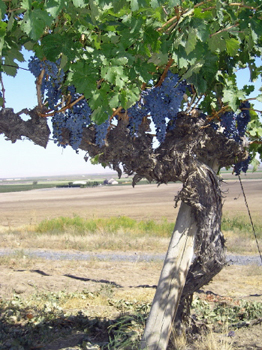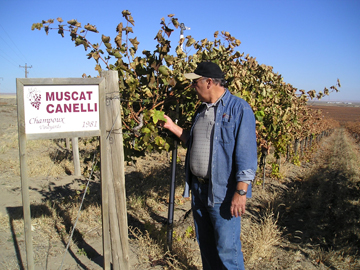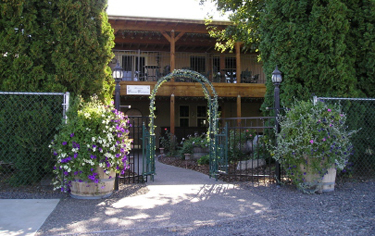

Vines dating back to 1972 are gnarly and the size of trees but continue to produce grapes coveted by Washington wineries.
Champoux Vineyard Reveals
History in the Horse Heaven Hills
Paul Champoux tends some of Washington’s oldest vines, and grows some history of his own.
by
Anne Sampson
December 12, 2007
 hen up-and-coming Washington winemakers go shopping for grapes, many of them knock on Paul Champoux’s door. As the managing partner of Chateau Vineyards, he knows a thing or two about making great wine, although he’s never crushed a grape.
hen up-and-coming Washington winemakers go shopping for grapes, many of them knock on Paul Champoux’s door. As the managing partner of Chateau Vineyards, he knows a thing or two about making great wine, although he’s never crushed a grape.
Champoux believes – and his customers seem to agree – that “80 percent of a fine wine is made in the vineyard”. Fruit from Champoux is highly regarded. Winemakers clamor for it, and wine judges reward it generously. Champoux’s customer list reads like a roll call of who’s-who in Washington wines: Quilceda Creek, Soos Canyon, Andrew Will, Fidelitas, and Woodward Canyon, to name a few.
Champoux has been farming in the Horse Heaven Hills for nearly 30 years, but some of his vines are even older. One of the blocks that he works today was put in the ground in 1972 by Walter Clore, the Washington State University researcher whose belief in the virtues of Eastern Washington sun and soil launched the wine industry here.
“Those trunks are gnarly,” Champoux laughed as we drove through the vineyard recently on a bright November morning after the vines had been picked clean of fruit. “Those old vines are just beautiful. They’re like tree trunks, they’re so old.”
Champoux conducts vineyard tours and tastings by appointment at Chateau Champoux, the tasting room he operates at the vineyard with his wife Judy. An

Paul Champoux checks out Muscat Canelli vines in his Horse Heaven Hills AVA vineyard.
“My job is to give the winemakers the best grapes that I can,” he told me. “I try to do that with plant nutrition that accentuates flavors, and with varietal character and sugars.”
Champoux began his career in 1979 managing vineyards for Chateau Ste. Michelle. In 1986, he began working for the Mercer family, on the land that today bears his name. Ten years later, he teamed up ith several business partners to buy the property. Over the course of three decades in the field, Champoux has developed a passion for feeding his grapes, coaxing them into the best possible array of flavors, sugars and tannins.
“Plant nutrition is a real key to growing premium red varieties,” he said. “One of the signatures of our vineyard here is good flavors. You can taste the fruit in all three spots of your mouth – the tip of your tongue, your mid-palate, and the back of the mouth where you taste tannins. It’s different than the vineyards right next to me, so that tells me that plant nutrition is a real key to accentuating flavors and varietal character.”
The Four Growing Seasons of Vines
Champoux has developed a series of applications of foliar nutrients that allow him to jump-start a plant’s maturation. A vine goes through four “growing seasons,” he explains. “After the first initial growth, then the plant goes through its reproductive cycle. That’s followed by a second growth cycle, and then it goes through the maturation cycle, the ripening of your fruit. Each one of those seasons of the vine, I put on a different nutritional package of foliar nutrients. I’m feeding the plant for the process it’s in.”Determining the right assortment of nutrients takes a little bit of scientific analysis, and a lot of experience. His nutrition program doesn’t vary greatly from one season to the next, Champoux said, but it’s not exactly a standard formula, either. “You have to react to what Mother Nature gives you,” he told me. “The plant doesn’t grow as fast when there’s a cool spring, so you might have to kick it in gear a little bit. Or you might have to slow it down later in the season. You have to be in tune with the weather, with what the vine tells you it needs.”
Champoux analyzes tissue samples every year, looking for the right moment to work his nutritional magic. “I try to start feeding the sugar conversion process, when the plant converts carbohydrates to sugar,” he said. He looks most closely at the minor nutrients – zinc and manganese, for example – that must be in the proper ratios for the plant to maximize major nutrients like phosphorous. “I try to start that as early as I can. Whatever it takes, I’m putting nutrients on the plant to speed the process.”
His fruit, like all the grapes grown in the Horse Heaven Hills, has grown better with each passing year, just as the wine it produces improves with age. “There’s no doubt about it,” he said. “There’s lots of improvement for three reasons – the growers are getting better, the vines are getting older, and the winemakers understand this area and their end product better - what they’re really shooting for.”
Winemakers might aim for a particular price point, he explained, but his clients look even more closely at varietal character. It’s all about the flavors. The long hot summers (the Horse Heaven Hills AVA averages 3,000 heat units a year)

Champoux conducts vineyard tours and tastings by appointment at Chateau Champoux, the tasting room he operates at the vineyard with his wife Judy.
“The hang time has nothing to do with sugars, in my mind,” he said. “It’s easy in this appellation to get sugars because we have so many heat units.” But when sugars begin to develop early, the flavors are right behind. The longer the grapes ripen on the vine, the deeper and more intense their varietal character, he explained.
Those are the strengths so famously exploited by Champoux’s clients. Some of Washington’s finest – from Mike Januik (Januik Winery ) to Paul Golitzin (Quilceda Creek) to Rick Small (Woodward Canyon Winery) – have taken Champoux grapes to the upper limits of their varieties, most notably Quilceda Creek, the boutique producer that earned back-to-back 100-point ratings for their 2002 and 2003 Cabernet Sauvignon, crushed from grapes born in Champoux Vineyard. Several of Champoux’s winemakers pay tribute by bottling Champoux Vineyard-designated wines.
“I have five different blocks of Cabernet Sauvignon, and most of my high-end guys get a piece of each one of those five blocks,” Champoux said. “Most winemakers say they like to blend, and that’s why they don’t do vineyard-designated wines. But here the










 READER FEEDBACK: To post your comments on this story,
READER FEEDBACK: To post your comments on this story,


